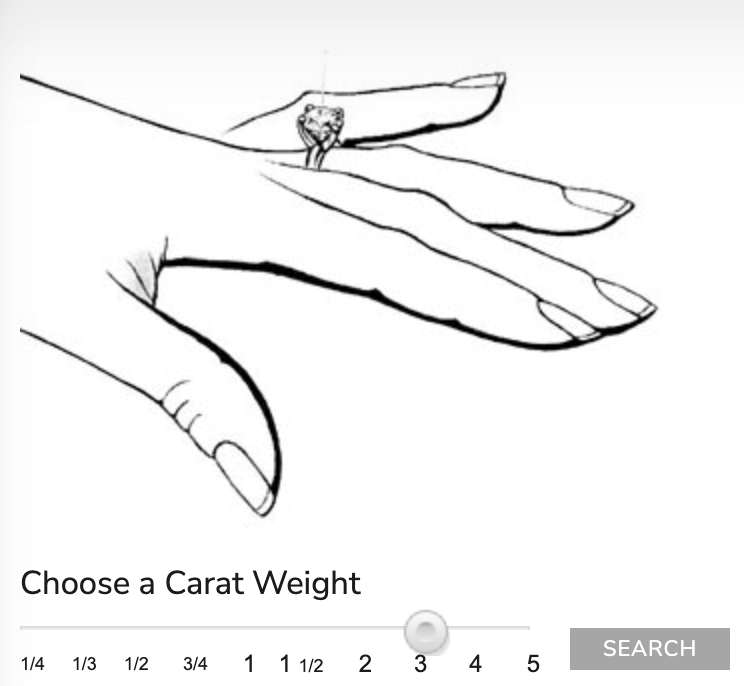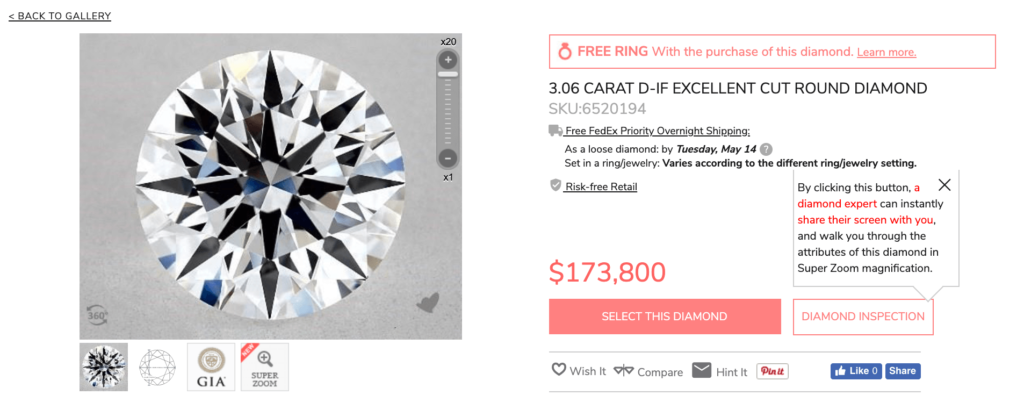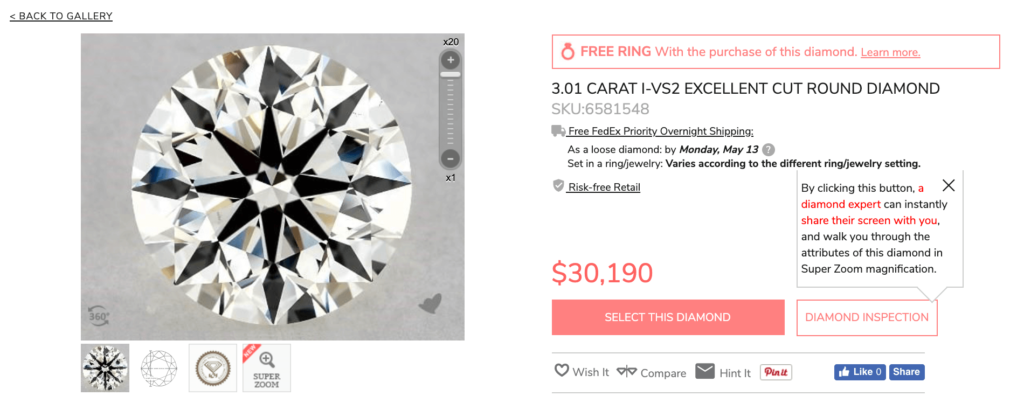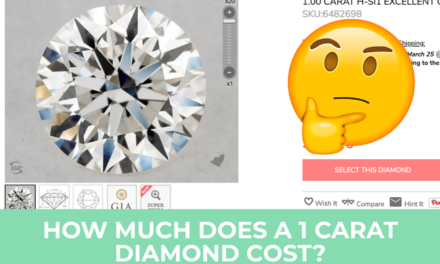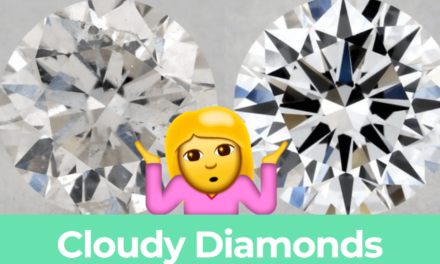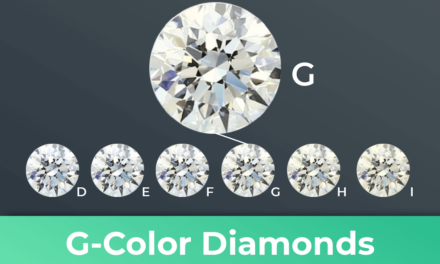My website is reader-supported. Buying through links on my site may result in me earning a CUSTOMER REFERRAL FEE at no extra cost to you.
Check out the latest deals at our top diamond vendor choice: James Allen
3 CARAT DIAMOND RING – All You Need To Know
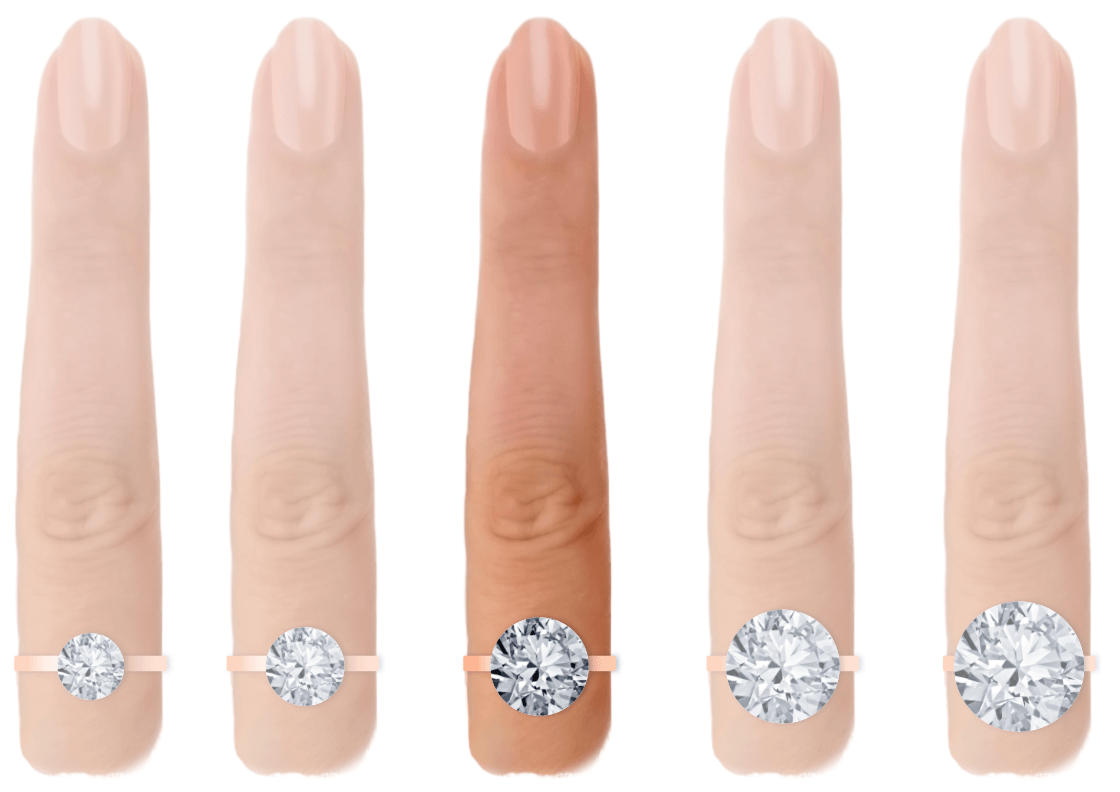
Size of a 3 carat diamond ring, round diamond cut
When it comes to diamonds, size does matter – particularly when it comes to getting engaged. If you’re looking for an engagement ring with a wow factor, a 3-carat diamond is the way to go. But before you start shopping around, there are a few things you need to know.
In this blog post, we’ll take a close look at 3-carat diamonds and everything you need to know before making such a big purchase. So whether you’re just starting your research or you’re ready to buy, read on for all the information you need.
Content overview
- How big is a 3 carat diamond?
- How to make the diamond appear even bigger
- What is the optimal diamond clarity grade for a 3 carat diamond
- What’s the best color grade for a 3 carat diamond
- Which cut grade should I get for a 3 carat diamond
- Shopping recommendations (summary)
- How much does a 3 carat diamond cost (diamond prices of natural and lab grown diamonds)?
- Where to buy a three carat diamond ring
- Conclusion
3-Carat Diamond Summary
- A 3-carat diamond is far above the average diamond engagement ring size, which currently lies between 0.9 and 1.2 carats
- Since a 3-carat diamond has a relatively large surface area, the diamond is more prone to showing off its body color and inclusions, that’s why you need to opt for slightly higher clarity and color grades compared to smaller diamonds
- I recommend that you choose a clarity grade at or above the VVS2 level, a color grade of I-K for rose or yellow gold settings and H-I for white gold or platinum settings; the cut grade should be ideal for optimal light performance
- The best places to shop for 3-carat diamonds are James Allen and Blue Nile
HOW BIG IS A THREE CARAT DIAMOND?
As a rule of thumb, the higher the carat weight, the larger the diamond appears to be.
However, what many people get confused about is that the carat weight does equal diamond size. Diamond carat weight is a measurement of the mass of a diamond. One carat equals 200 milligrams (0.002 kilograms) or about 200 grains of salt.
Two diamonds of the same carat weight can look different in size. Take a look at the two loose diamonds below, for example:
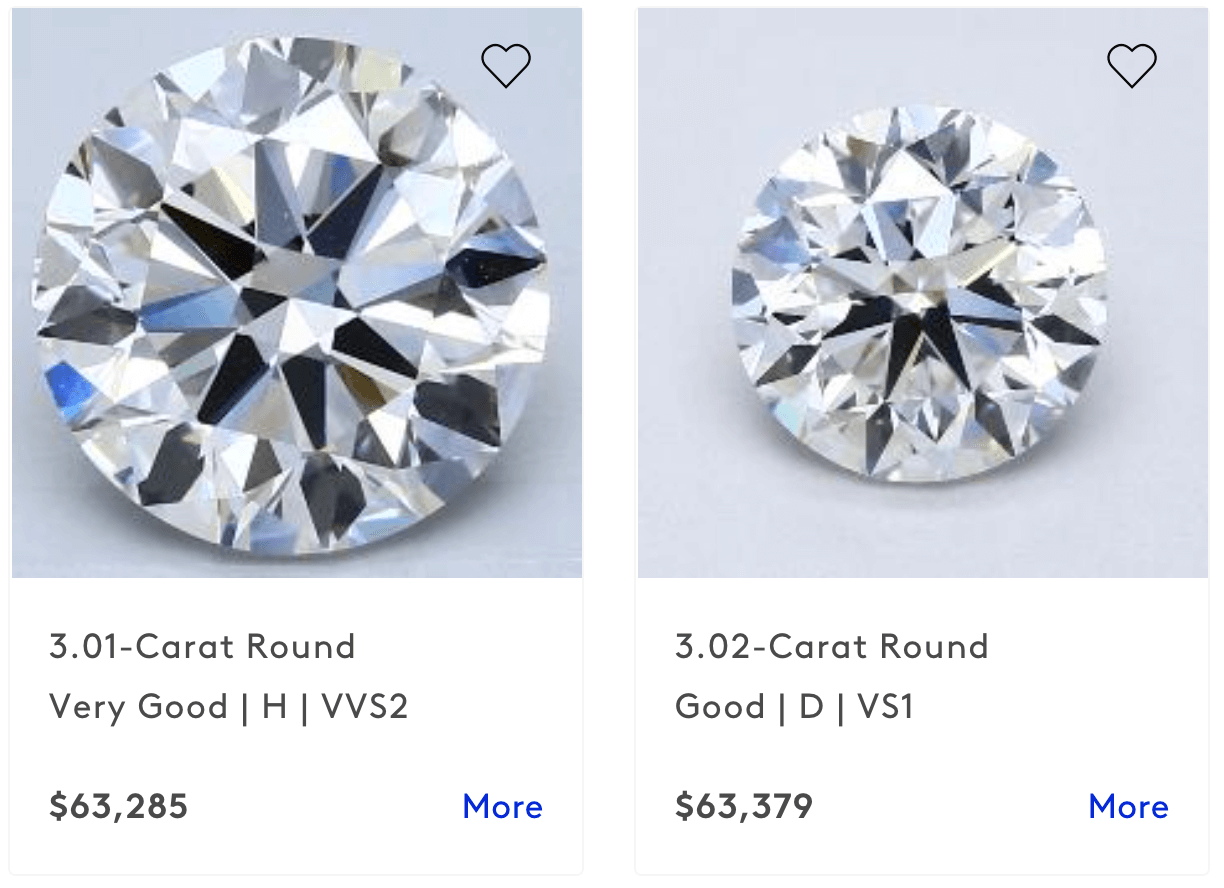
Both diamonds have a carat weight of three, yet the one on the left is significantly larger than the one on the right.
However, on average, a three-carat diamond is less than 3/5th of an inch in width and length.
What some people find surprising is that the size of a diamond does not influence the diamond’s value, unlike carat weight, color, and cut grade.
Two diamonds can differ dramatically in size, yet the smaller diamond can still cost significantly more than the larger diamond. Take a look at the two diamonds from Blue Nile below to see what I mean:
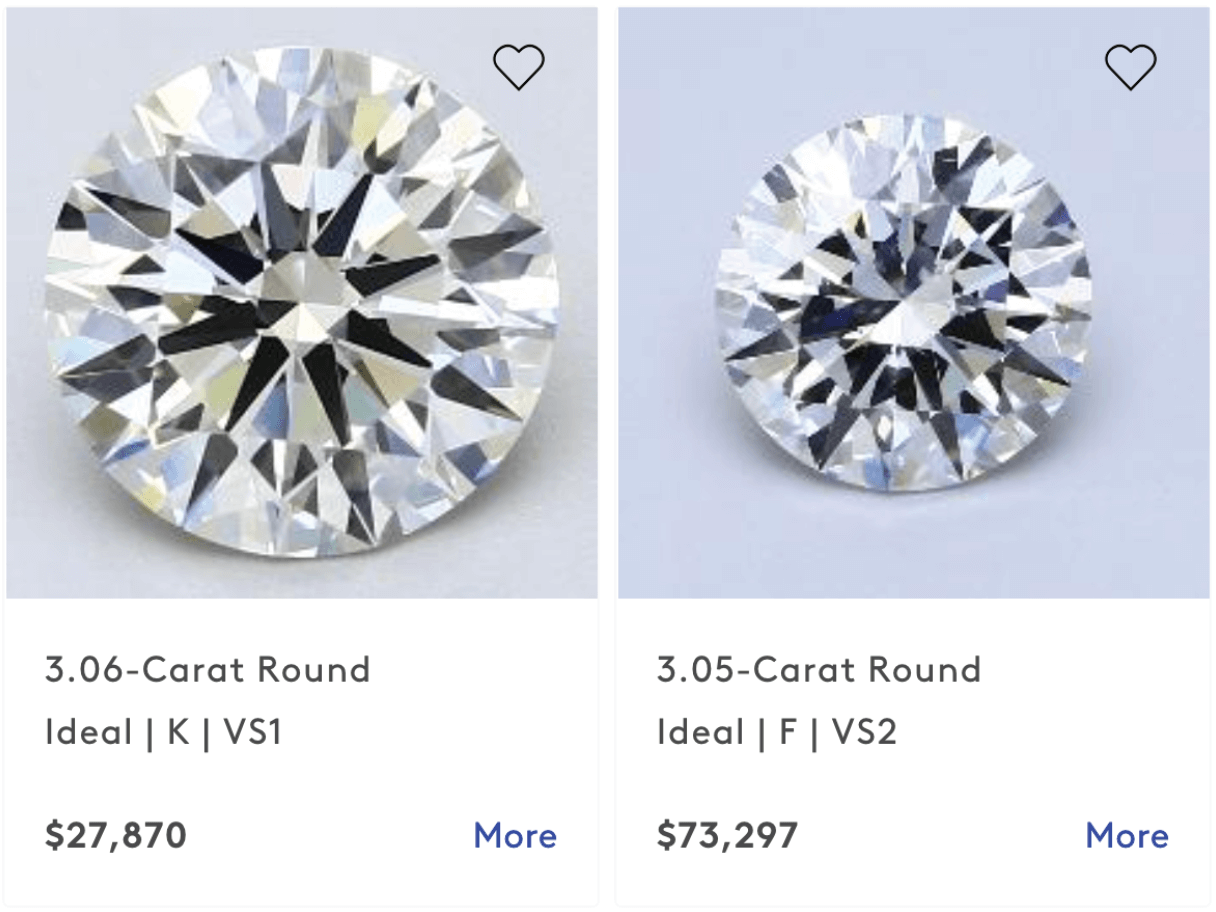
The diamond on the left is almost half the size of the one on the right, but twice the price!
To get a picture of what an average-sized three-carat vs. a one-carat diamond would look like, check out James Allen’s diamond size engagement ring simulator:
HOW TO MAKE THE DIAMOND APPEAR EVEN BIGGER?
If you are in the market for a large diamond, you are probably interested in learning how to make a large diamond appear even larger.
Here are some simple ways on how to make any diamond appear larger (without spending more money):
- Choose a small ring band: I suggest keeping it minimal for the best engagement ring settings for a 3-carat diamond. Nothing pops more than a 3 carat stone on a barely-there, 1.5mm band. You want the diamond to be the center of attention, after all.
- Choose a diamond that has great optical characteristics: If your diamond lacks bright white light reflection or scintillation, it will look smaller than it is; if you choose the optimal cut, color, and clarity grade, your diamond will sparkle and appear larger.
- Consider a fancy shape diamond: Certain diamond shapes make the diamond appear larger than the traditional round cut diamond; for example, an oval or emerald cut diamond will look more significant than a brilliant round diamond.
- Consider engagement ring settings other than a solitaire setting: If you choose a 3-stone diamond ring setting, for example, the center stone will automatically appear larger.
THE OPTIMAL CLARITY GRADE FOR 3 CARAT DIAMOND ENGAGEMENT RINGS
A 3-carat diamond tends to have a large surface area due to its overall size. That’s why in diamonds of this size, imperfections and poor-quality cuts are more easily spotted than with lower Carat weights.
This means that for a 3-carat diamond, you’ll need to choose slightly higher clarity and color grades than you would for a smaller diamond. Your goal is to find an eye-clean diamond, meaning that no flaws are visible to the naked eye.
The Gemological Institute of America (GIA) has created a scale for measuring diamond clarity. Flawless (FL) diamonds are considered the highest quality. These are followed — listed here in order from higher quality to lowest quality — by diamonds with:
- Almost invisible internal flaws (IF)
- Diamonds with very, very small inclusions 1 (VVS1), then very, very small inclusions 2 (VVS2)
- Very small inclusions 1 (VS1), very small inclusions 2 (VS2)
- Small inclusions 1 (SI1), small inclusions 2 (SI2)
- And finally, inclusions 1 (I1) and inclusions 2 (I2).
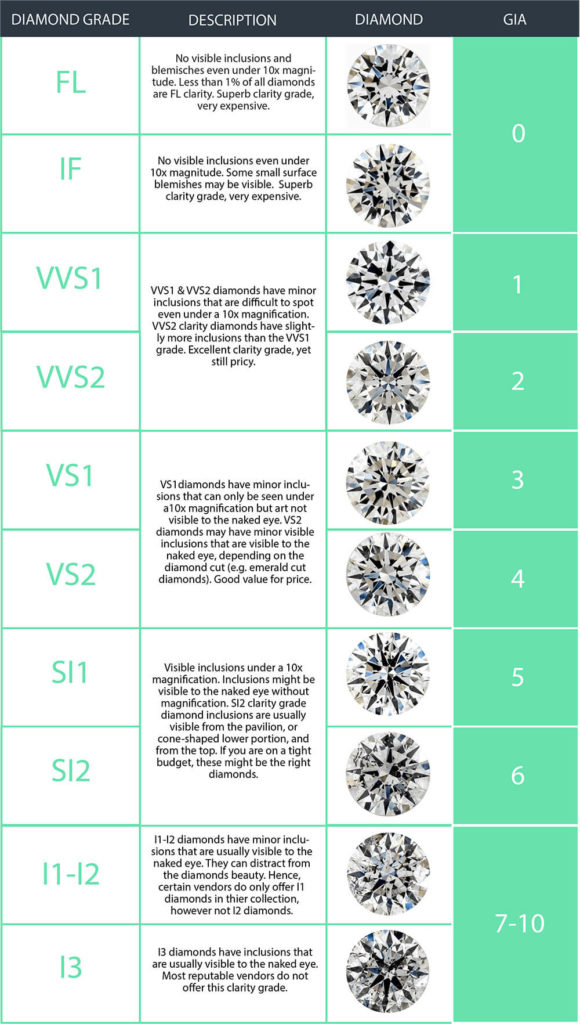
Naturally, the higher the clarity rating, the more valuable the diamond.
The ideal range for a good quality diamond in the 3-carat range is a clarity grade of VS2 or better.
Diamonds with VS1 or VS2 ratings will typically have no visible flaws but will be much less expensive than those with higher clarity ratings. The shape of the stone will also determine the level of clarity you should look for. For instance, you can get away with a lower clarity grade on round brilliant cut diamonds because their intense sparkle and shine mask any flaws. For shapes such as emerald, though, clarity is even more important because the way the facets are cut makes flaws even more visible.
Take a look at the two examples below:
The Optimal color grade for a 3 carat diamond
Just like inclusions and blemishes, the color of a diamond becomes more apparent as carat weight increases, as well.
A diamond’s color grade, ranging from D (completely colorless ) to Z (yellow), actually measures how little color it reflects.
When choosing a diamond color, your ultimate goal is to find a diamond that looks colorless against the ring setting.
Luckily, that doesn’t mean that you have to choose a D-colored diamond. You can easily choose a lower color grade and still have the diamond appear “white.”
To strike the best balance between cost and beauty, you should choose the following color grades:
Rose gold/yellow gold setting: Color grade of I-K
Platinum/white-gold setting: Color grade of H-I
Some people are hesitant about choosing a low color grade because they think that their diamond will look to yellow. But I can assure you, it will not.
For example, take a look at the two 3-carat diamonds below. The one on the left has an E-color grade, the one on the right has an H-color grade. Yet both look quite similar in color:
 And while you can’t see a dramatic difference in color, you certainly can see a difference in the price.
And while you can’t see a dramatic difference in color, you certainly can see a difference in the price.
The optimal cut grade
CUT is the primary feature determining how brilliant and beautiful it is overall. Nothing else comes even close, not color and not clarity. Many people are under the illusion that better clarity and color create a diamond’s beauty. This could not be farther from the truth.
I’ll show you why with the following loose diamond:
IF (internally flawless) clarity, D color diamond – $173,800
VS2 clarity, I color diamond – $30,190
Most consumers would naturally assume that an internally flawless D color diamond would be just about “perfect.” Especially since it has a price tag is over $150,000.
Well, take a close look, and you’ll see that the IF clarity D colored diamond is excessively dark under its table. This so-called “perfect” stone has average proportions and inferior light performance or sparkle.
Contrast that with the VS2 clarity I colored diamond below, which costs only a fraction of the “flawless” diamond. You can see that it is far more beautiful.
Just look at the stone’s light performance! There is no comparison. I can guarantee that the I-colored diamond will win by a mile when the two are compared side-by-side.
The truth is that a diamond needs neither flawless clarity nor perfect color to look incredible. These factors determine how rare they are and, therefore, their “value.”
Summary of buying recommendations
Below are my clarity and color recommendations for white gold- and yellow gold settings (based on the GIA color scale and clarity scale).
Diamond Ring with a Platinum or White Gold Setting
- Diamond Color: H-J
- Cut: I always recommend an ideal cut, as the cut quality largely determines your diamond’s sparkle
- Clarity Grades: VS2 or higher (the higher the clarity grade, the more challenging it will be to find a diamond without inclusions visible to the naked eye).
Diamond Ring with a Rose Gold or Yellow Gold Setting
- Diamond Color Color: I-K
- Cut: Ideal cut
- Clarity Grades: VS2 or higher
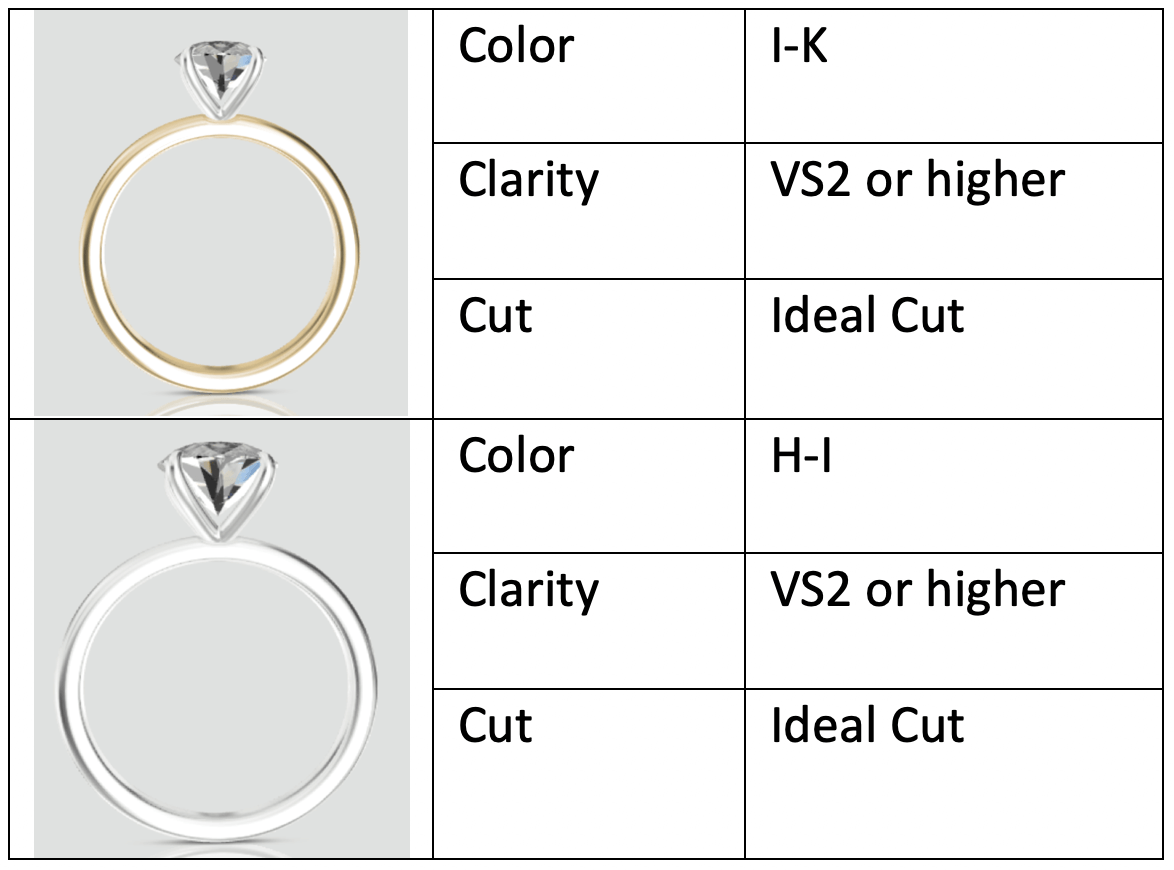
Note: For fancy shaped diamonds, such as a princess cut diamond or other shapes, you might want to choose slightly higher clarity rating and color grades, as these cuts emphasize the diamond’s color and clarity.
HOW MUCH DO 3 CARAT DIAMOND RINGS USUALLY COST?
The answer is not straightforward because a diamond’s value is determined by several factors, not just carat weight. Other factors include parameters such as clarity, color, and cut grade, as well as a diamond shape. Furthermore, it also matters whether you are looking at natural diamonds or a lab-created diamond.
A natural, round-cut 3-carat diamond can cost anywhere from $15k-$150k if you purchase one online. In a brich=j-and-mortar store, you can expect to pay up to 50% more.
A lab-created, round-cut 3-carat diamond ranges from $11k to $30k.
Below you can see how the carat weight impacts the pricing of natural- and lab-grown diamonds:

As you can see, the price of a diamond increases disproportionally to the diamond’s carat weight.
WHERE TO BUY A 3 CARAT DIAMOND ONLINE?
If you go online to James Allen or Blue Nile, you’ll immediately be searching through 3-carat diamonds by the hundreds from the privacy of your home.
Furthermore, you’ll be able to examine diamonds in far more detail than you would ever be able to in a retail store. What’s even better is, you won’t even have to use a loupe or squint your eyes to inspect these diamonds!
Shopping online for diamonds is a far more exacting process than looking at diamonds in stores. Sellers like James Allen and Enchanted Diamonds allow you to examine every stone via high-definition videos. They provide accurate cut data to use in your analysis. This gives you a huge advantage because you can make your decision rationally without being pressured.
When you’re given accurate data and facts to work with, you’re not dealing in the realm of guesswork when buying diamonds.
By the way, at James Allen, you can use a simulator that shows you what different carat sizes would look like on an average finger. You can also see what a 3-carat diamond engagement ring would look like.
Conclusion
Because of the significant carat weight, most 3-carat diamond rings offer a brilliant sparkle and have an amazing look to them.
Now that you know all the factors that go into a high-quality 3-carat diamond, you can set your budget accordingly and find the perfect diamond engagement ring
Consider a lab-grown diamond if your heart is not set on a natural diamond. While relatively rare in this size, you can save a considerable amount of money if you find a good one.
Whichever diamond you choose, always make sure to only purchase one from a reputable vendor with the appropriate diamond certificate.

